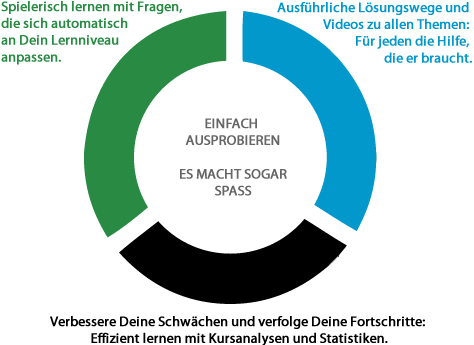Möchtest Du diesen Kurs als Gast durchführen?
Um im Highscore-Modus gegen andere Spieler antreten zu können, musst du eingeloggt sein.
Englisch
Bedingungssatz Typ 3 (If-Clause 3)
If-Satz Typ 3
Bibliothek durchsuchen:
ENGLISCH-ÜBUNGEN ZU
BEDINGUNGSSATZ TYP 3 (IF-CLAUSE 3)
If-Satz Typ 3
kostenloser Kurs
Dieser Kurs beinhaltet Aufgaben zu:
Bedingungssätze Typ 3 / If-Sätze Typ 3:
Bedingungssätze Typ 3 / If-Sätze Typ 3:
- Bildung von Verben im Past Perfect Simple
- Bildung von Verben im Conditional Perfect
- Bildung und Verwendung von Bedingungssätzen Typ 3
- Verneinung von Verben in Bedingungssätzen Typ 3
Diesen Kurs bei Deinen Favoriten anzeigen
KURZ ERKLÄRT
BEDINGUNGSSATZ TYP 3 (IF-CLAUSE 3)
If-Satz Typ 3
If-Sätze sind Teil von sogenannten Bedingungssätzen. Bedingungssätze bestehen aus einem Nebensatz (= if-Satz) und einem Hauptsatz. Der Nebensatz (if-Satz) drückt hierbei die Bedingung und der Hauptsatz die Folge aus. If-Sätze des Typs 3 werden verwendet, wenn die Erfüllung einer Bedingung unmöglich ist, da die betreffende Handlung bereits vorbei ist.
Nebensatz (= if-Satz) in einem Bedingungssatz Typ 3
Der Nebensatz, auch if-Satz genannt, steht im Past Perfect Simple.
Bildung des Past Perfect Simple:
had + Past Participle
Regelmäßige Bildung des Past Participle:
Vollverb im Infinitiv + -ed
Es gibt allerdings auch unregelmäßige Verben, z.B. come → come,
know → known, be → been.
In negativen Sätzen lautet die Bildung had + not (= hadn‘t) + Past Participle.
had + Past Participle
Regelmäßige Bildung des Past Participle:
Vollverb im Infinitiv + -ed
Es gibt allerdings auch unregelmäßige Verben, z.B. come → come,
know → known, be → been.
In negativen Sätzen lautet die Bildung had + not (= hadn‘t) + Past Participle.
Das Past Perfect Simple ist für alle Personen gleich.
Beispiele:
If I had booked a flight to London, …
If she had left without saying goodbye, …
If he hadn‘t broken his leg, …
If they hadn‘t cleaned the apartment, …
Hauptsatz in einem Bedingungssatz Typ 3
Der Hauptsatz steht im Conditional Perfect.
Bildung des Conditional Perfect:
would + not (= wouldn‘t) + have + Past Participle
Regelmäßige Bildung des Past Participle:
Vollverb im Infinitiv + -ed
Es gibt allerdings auch unregelmäßige Verben, z.B. go → gone, put → put, write → written.
In negativen Sätzen lautet die Bildung would + not (= wouldn‘t) + have + Past Participle.
would + not (= wouldn‘t) + have + Past Participle
Regelmäßige Bildung des Past Participle:
Vollverb im Infinitiv + -ed
Es gibt allerdings auch unregelmäßige Verben, z.B. go → gone, put → put, write → written.
In negativen Sätzen lautet die Bildung would + not (= wouldn‘t) + have + Past Participle.
Das Conditional Perfect ist für alle Personen gleich.
Beispiele:
…, he would have talked to her.
…, they would have been very sad.
…, she wouldn’t have gone that far.
…, we wouldn’t have replaced the mixer.
Im Hauptsatz können anstelle des Conditional Perfect auch die Modalverben could oder might + Perfect Infitinive stehen:
could/might + have + Past Participle
could/might + have + Past Participle
Beispiele:
…, I could have been in Japan by now.
…, she might have graduated from high school by now.
Der Bedingungssatz Typ 3
Bildung des Bedingungssatzes Typ 3:
Nebensatz im Past Perfect Simple (= if-Satz) + Komma + Hauptsatz im Conditional Perfect
oder:
Hauptsatz im Conditional Perfect + Nebensatz im Past Perfect Simple (= if-Satz)
Nebensatz im Past Perfect Simple (= if-Satz) + Komma + Hauptsatz im Conditional Perfect
oder:
Hauptsatz im Conditional Perfect + Nebensatz im Past Perfect Simple (= if-Satz)
Der Nebensatz kann sowohl vor, als auch nach dem Hauptsatz stehen. Steht er an erster Stelle, wird er mit einem Komma vom Hauptsatz abgetrennt. Steht er an zweiter Stelle, wird kein Komma verwendet.
Beispiele:
If you hadn’t listened to me, I would have yelled at you.
If they had looked for the key more thoroughly, they would have found it.
Martha would have thrown the money out of the window if the police had entered.
The two friends would have ordered more food if they had had any money left.
SO FUNKTIONIERT UNTERRICHT.DE

VERWANDTE KURSE
Kurse für Bedingungssätze (If-Sätze):
Bedingungssatz Typ 1 (If-Clause 1)
Bedingungssatz Typ 2 (If-Clause 2)
Bedingungssätze Typen 1-3 (If-Clauses)
Bedingungssatz Typ 1 (If-Clause 1)
Bedingungssatz Typ 2 (If-Clause 2)
Bedingungssätze Typen 1-3 (If-Clauses)
VIDEOS ZUM KURS
KOSTENLOSE KURSE:
ENGLISCH:
DEUTSCH:
BAYERISCHE WIRTSCHAFTSSCHULE:



